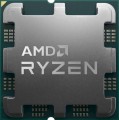Code name
This parameter characterizes, firstly, the technical process (see above), and secondly, some features of the internal structure of processors. A new (or at least updated) codename is introduced to the market with each new CPU generation; chips of the same architecture are "coevals", but may belong to different series (see above). At the same time, one generation can include both one and several code names.
Here are the most common Intel codenames today:
Cascade Lake-X (10th gen),
Comet Lake (10th gen),
Comet Lake Refresh (10th generation),
Rocket Lake (11th generation),
Alder Lake (12th generation),
Raptor Lake (13th generation),
Raptor Lake Refresh (14th generation).
For AMD, this list includes
Zen+ Picasso,
Zen2 Matisse,
Zen2 Renoir,
Zen3 Vermeer,
Zen3 Cezanne,
Zen4 Raphael,
Zen4 Phoenix and
Zen5 Granite Ridge.
Lithography
The technical process by which the CPU is manufactured.
The parameter is usually specified by the size of the individual semiconductor elements (transistors) that make up the processor integrated circuit. The smaller their size, the more advanced the technical process is considered: miniaturization of individual elements allows you to reduce heat generation, reduce the overall size of the processor and at the same time increase its flow Rate. CPU manufacturers are trying to move towards reducing the technical process, and the newer the processor, the lower the numbers you can see at this point.
The technical process is measured in nanometers (nm). In the modern arena of central processors, solutions made using the
7 nm,
10 nm,
12 nm process technology predominate, high-end CPU models are manufactured using the
4 nm and
5 nm process technology,
14 nm and
22 nm solutions are still afloat, and are rapidly fading into the background, but
28 nm and
32 nm occur periodically.
L1 cache
The amount of Level 1 (L1) cache provided by the processor.
Cache is an intermediate memory buffer into which the most frequently used data from RAM is written when the processor is running. This speeds up access to them and has a positive effect on system performance. The larger the cache, the more data can be stored in it for quick access and the higher the performance. Level 1 cache has the highest performance and the smallest volume — up to 128 KB. It is an integral part of any processor.
L3 cache
The amount of cache level 3 (L3) provided in the processor.
Cache is an intermediate memory buffer into which the most frequently used data from RAM is written when the processor is running. This speeds up access to them and has a positive effect on system performance. The larger the cache, the more data can be stored in it for quick access and the higher the performance.
Instruction
Support by the processor of various sets of additional commands. These can be instructions that optimize the operation of the processor as a whole or with applications of a certain type (for example, multimedia, or 64-bit), prevent certain types of viruses from running on the computer, etc. Each manufacturer has its own assortment of instructions for CPUs.
Max. operating temperature
The maximum temperature at which the processor is able to effectively continue to work — when heated above this temperature, most modern processors are turned off in order to avoid the unpleasant consequences of overheating (up to the burning of the chip). The higher the maximum operating temperature, the less demanding the processor is on the cooling system, however, the cooling power anyway should not be lower than TDP (see Heat Dissipation (TDP)).
Passmark CPU Mark
The result shown by the processor in the Passmark CPU Mark test.
Passmark CPU Mark is a comprehensive test that checks not only the gaming capabilities of the CPU, but also its performance in other modes, based on which it displays the overall score; this score can be used to fairly reliably evaluate the processor as a whole.
Max. RAM
The maximum amount of random access memory (RAM) that the CPU can work with correctly.
The larger the amount of RAM — the higher the power required to work correctly with it. Accordingly, any CPU will inevitably be limited in this parameter. However, even relatively modest modern CPUs can have very impressive maximum RAM volumes, calculated in tens of gigabytes. So, the most popular
CPUs with support for 64 GB and
128 GB RAM.
Max. DDR5 speed
The highest frequency of DDR5 RAM modules that the processor is compatible with.
DDR5 is being implemented in hardware to replace the fourth version of the DDR standard from the end of 2020. A typical "fork" of frequencies for modules of this generation is the range of 4800-6400 MHz. The maximum frequency of DDR5 memory reaches 8400 MHz.

